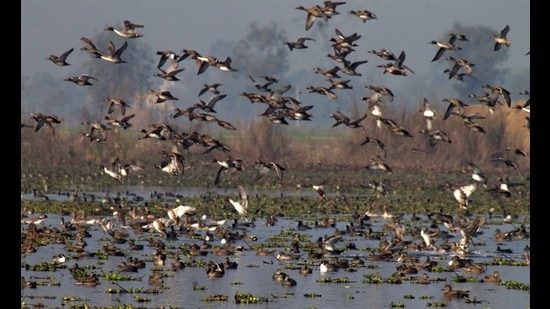Avian influenza threat: Forest officials raise a caution as migratory birds descend on Harike wetland
According to a rough estimate of the officials, around 10,000 birds, including rare species, have already arrived at the wetland, Hari-Ke-Pattan wetland; forest officials are cautious in the wake of avian influenza cases in Rajasthan
With the start of the arrival of winged guests from the different parts of Europe and North Asia to the India’s second largest wetland Harike, the state department of forests and wildlife preservation has started taking precautionary measures in view of the death of more than 170 birds in Rajasthan due to avian influenza.

According to a rough estimate of the officials, around 10,000 birds, including rare species, have arrived at the wetland, also known as Hari-Ke-Pattan. Though no case of bird flu has been reported at the Harike Pattan Bird Sanctuary, the monitoring of birds has been intensified.
The wetland and the lake were formed by constructing the headworks across the Sutlej river in 1953. Since then, the wetland spreading over 100 square miles has become a home to rare varieties of avifauna that arrive here from different countries.
“So far, no case of bird flu has been reported at Harike, but our precautions are in place. Our teams are regularly monitoring all activities there. The birds have just started arriving and their arrival will increase in the coming days,” said Ferozepur divisional forest officer, wildlife, Nalin Yadav.
The birds species that have reached Harike include bar-headed goose, greylag goose, ruddy shelduck, gulls, pintail duck, tufted duck, northern shoveller, wigeon, red-crested pochard, common teal, white-eyed pochard, knob-billed duck, black-headed ibis, marsh harrier etc. “More birds of these species will arrive in the coming months,” said Gitanjali Kanwar, coordinator, aquatic biodiversity, WWF India.
She said, “We have also spotted rare species of water birds in Harike, like black-tailed godwit, golden plover, ferruginous pochard, greater flamingo, greater spotted eagle, etc.”
“Due to extra precautionary measures keeping in view of the reports of bird flu in some parts of the country, including Rajasthan, there is no case of death of any bird at Harike. The department’s teams are working round the clock to ensure the safety of birds,” she added.
When asked about the effect of smog on the migratory birds, she said, “During our recent years’ study, we have found that there is no major impact of smog on the avian guests visiting Harike. The water body at Harike is quite large and these birds can easily locate it while flying.”
Gitanjali expects more than 1 lakh migratory birds at the wetland by January. The officials have also increased their security against the poaching activities.
Every year, thousands of winged guests from low-temperature regions arrive at the world-famous bird sanctuary in the first week of November as lakes of those regions freeze in winter. They are expected to stay here till March. Last year, a total of 90 species were recorded, including three unidentified.
Last year, nearly 75,000 migratory birds had arrived at the wetland, which was the lowest in over six years. The officials had cited ‘some undescribed issues in the low temperature regions’ for the low number. In 2019, the count of migratory birds that arrived at the wetland was around 1,23,000; and the number was 95,000 in 2018; 93,000 in 2017; and 1,05,000 in 2016.



